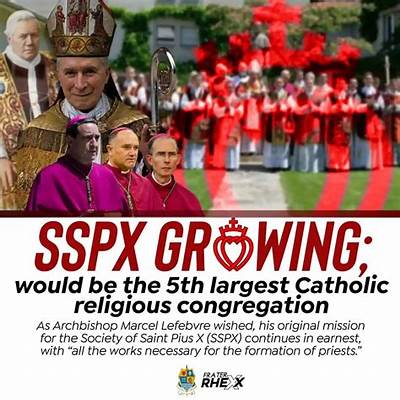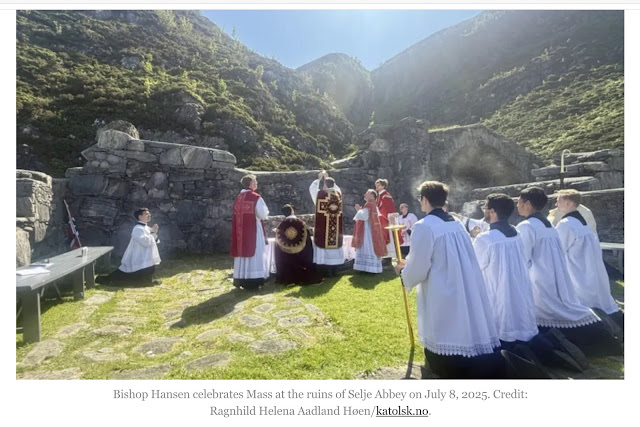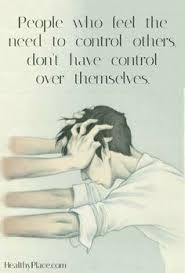My valuable insights into what Pope Leo has said in this speech, embedded in the text in
In the name of the Father, of the Son and of the Holy Spirit.
Peace be with you!
Dear formators, dear Xaverian brothers,
I am pleased to meet you at the conclusion of two important events in which you have participated here in Rome: the Course for Seminary Formators, promoted for many years now by the Pontifical Athenaeum Regina Apostolorum, and the General Chapter to which some of you were delegates.
These are certainly two different events, yet we can see a common thread that unites them because, in different ways, we are called to enter into the dynamism of mission and to face the challenges of evangelization. This call requires of us all, ordained ministers and lay faithful alike, a solid and integral formation, which is not limited to specialized knowledge, but must aim to transform our humanity and our spirituality so that they reflect the Gospel, and so that we have “the same mind” as Christ Jesus (cf. Phil 2:5). (Pope Leo hits the nail on the head. Intellectual knowledge about the Catholic Church, her history, teachings and spirituality is important but never disembodied from living the Catholic Faith in all its orthodox glory.)
To you who are responsible for the formation of formators, and to you Xaverian brothers who are particularly committed to the missio ad gentes, I would like to offer some thoughts for reflection. Recently, the Dicastery for the Clergy hosted an international gathering dedicated to priests on the theme, “Joyful Priests.” We can add that to be enthused by the joy of the Gospel is not just for priests, but for everyone, and so we can speak of happy Christians, happy disciples and happy missionaries. (Yes, there needs to be a joy, an infectious joy in the clergy that inspires the laity to follow suit! The laity’s role is minuscule in “Churchy, institutional realities” but profound in a majority sense in the world, at home, at work, in politics and the public square, where an orthodox and joyful Catholic Faith is a most powerful form of mission and evangelization lived out by the laity!)
If this hope is not to remain a mere slogan, formation is essential. Indeed, it is necessary that the “house” of our life and vocational journey, whether priestly or lay, be founded on “rock” (cf. Mt 7:24-25), that is, on solid foundations with which to face the human and spiritual storms from which even the lives of Christians, priests and missionaries are not exempt. How can we build our house on rock? In this regard, I would like to offer you three brief suggestions. (Of course, the rock is Jesus Christ, crucified, Risen and Glorified and living now in the now in relationship to every individual as well as the communal charism of the institutional Church!)
The first is to cultivate friendship with Jesus. This is the foundation of the house, which must lie at the heart of every vocation and apostolic mission. We need personally to experience the closeness of the Master; to know that we have been seen, loved and chosen by the Lord by pure grace and without merit on our part, because it is above all our own personal experience that we then exude in our ministry. Moreover, when we form others in the priestly life and, according to our specific vocation, proclaim the Gospel in mission lands, we first radiate our personal experience of friendship with Christ, which shines through in our way of living, in our attitude, in our humanity, and in how we are capable of living out healthy relationships. (This is extremely important for the vision of synodality that Pope Leo will promote, it is powerfully Christo-centric and based upon relationships, first the one of unconditional love Jesus has for us and by His grace, our ability to reciprocate to Him and our neighbor and how the Holy Spirit unites us in the joy of Orthodox Catholicism and the ortho-praxis of our Catholic Faith.)
Recalling the words of Evangelii Nuntiandi during a General Audience, Pope Francis said: “Evangelization is more than just simple doctrinal and moral transmission. It is, first and foremost, witness... witness of the personal encounter with Jesus Christ, the Incarnate Word in which salvation is fulfilled... It is not transmitting an ideology or a “doctrine” on God, no. It is transmitting God who is living in me” (General Audience, 22 March 2023). (Say what you want about the confusion that Pope Francis’ non-magisterial gestures produced, His Holiness was Christo-centric too, but unfortunately his off-the-cuff statement, some of his public gestures and printed interviews undermined what was good in His Holiness’ Christology and personal relationship with his Savior.)
This entails a continuous journey of conversion. Formators, and those responsible for them, must not forget that they themselves are on a journey of permanent evangelical conversion. At the same time, missionaries must not forget that they are always the first recipients of the Gospel, the first to be evangelized. This means that we are constantly to work on ourselves. A concerted effort is needed to look into our hearts in order to see the shadows and wounds that mark us, and then to have the courage to abandon our masks and cultivate an intimate friendship with Christ. In this way, we will allow ourselves to be transformed by the life of the Gospel and become authentic missionary disciples. (We all know that agnostics and atheists can know and even love all that the Catholic Church teaches and they might know these teachings far better than most clergy and laity, but still remain an agnostic and an atheist. They live in the realm of academic pursuit and the love of learning, but don’t allow it to touch them personally! In other words, there isn’t conversion. This can happen to believing Catholics who in the pursuit of intellectual Churchy pursuits lack conversion to Catholic orthodoxy and orthopraxis, but drift towards heterodoxy and heteropraxis!)
The second suggestion is to live an effective and affective fraternity among ourselves. When Pope Francis spoke about priestly life and the crises to be prevented, he liked to emphasize four kinds of closeness: closeness to God, to the bishop, to fellow priests, and to the people (cf. Address to Participants in the Symposium “Towards a Fundamental Theology of the Priesthood,” 17 February 2022). In this sense, it is necessary to learn to live as brothers within the presbyterate, as well as in religious communities and with our bishops and superiors. We must work hard on ourselves in order to overcome individualism and the desire to overtake others, which makes us competitors, so that we learn gradually to build human and spiritual relationships that are both healthy and fraternal. In principle, I think everyone agrees on this, but in reality there is still a long way to go. (Very good point. Today, because of social media a priest who distances himself from his brother priests and his bishop, and also the pope, becomes a Lone Ranger, a kind of cult figure either in his parish or on social media. We have examples of that all over the Church! My deceased bishop who ordained me, Bishop Lessard, used to warn against congregationalism, where priests and parishes did their own thing independent of the leadership of the bishop and the common thread in diocesan parishes.)
The third and final aspect is to share the mission with all the baptized. During the first centuries of the Church, it was usual for all the faithful to be like missionary disciples and to commit themselves personally to evangelization. The ordained ministry was at the service of this mission shared by all. Today, we feel strongly that we must return to this participation of all the baptized in witnessing to and proclaiming the Gospel. Brothers of the Society of Saint Xavier, in the lands where you carry out your mission, you will certainly have seen firsthand how important it is to work together with the sisters and brothers of those Christian communities. At the same time, I would like to say to the formators that priests must also be trained in this, not to think of themselves as lone leaders, nor to live out the ordained priesthood with a sense of superiority. We need priests who are able to discern and appreciate in lay people the grace of Baptism and the charisms that flow from it, perhaps even helping them to open up to these gifts and then to find the courage and enthusiasm to commit themselves to help the life of the Church and society. In concrete terms, this means that the preparation of future priests must be increasingly immersed in the reality of the People of God and carried out with the contribution of its members: priests, laity, and consecrated men and women. (What I appreciate the most about Vatican II is its call to holiness for all the laity. And Vatican II made clear that the primary role of the laity is in the world, where the Church and her orthodox ethos is brought to the world, at home, in the work place, at play, in politics and the public square. But malformed Catholics, individualistic in their heterodoxy, bring not the pristine Catholic Faith to where they find themselves, but a heterodoxy, a toothless Catholicism or a manipulation of Catholicism for political purposes opposed to Catholic teaching. Think of all the heterodox Catholic politicians we have in the USA and the heterodox example they give to fellow Catholics and the world. This compromises the call to laity to be holy and orthodox and to be missionaries and evangelizers in the world! Often, unfortunately, they have been formed in their heterodoxy by heterodox clergy and religious! In addition to this dismal situation, more attention is paid to the laity doing “churchy” things, as Bishop Lessard used to say, rather than how they are to live holy lives in the world in their own secular lives. The vast, vast, vast majority of lay Catholics don’t have Church jobs, aren’t on committees, are not Eucharistic Ministers, lectors, ushers, choir members or working in the Curia of the Vatican! But that is were the energy has been placed for the last 60 years, on giving power to a small minority of laity, especially laywomen, not lay men, in churchy and institutional settings! Pope Leo is correct in getting back to enabling the laity to live and proclaim the Gospel in the secular realm, the realm of their life and where their Catholic expertise and personal holiness should be exercised!)
Dear friends, I thank you for this opportunity to be together, but above all, I thank you for your service, for your care in carrying out priestly formation, and for your missionary work in evangelizing lands that are often wounded and in need of the hope of the Gospel. I encourage you to continue on your journeys.
May the Virgin Mary accompany you and intercede for you!
Thank you!























